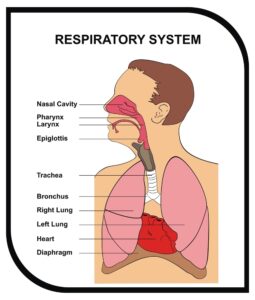Back to: Physical Health Education SS1
Welcome to today’s class!!
We are thrilled to have you in our class!!
In today’s Physical and Health Education class, we will be learning about the Respiratory System
Respiratory System
If you have ever imagined how you breathe in and out, you will want to learn about the Respiratory System.

The Respiratory System is the network of organs and tissues that help you breathe. It includes your airways, lungs, and blood vessels. The muscles that power your lungs are also part of the respiratory system. These parts work together to move oxygen throughout the body and clean out waste gasses like carbon dioxide.
Common problems associated with the Respiratory System include allergies, diseases, or infections.
The respiratory system has many functions. Besides helping the body to inhale (breathe in) and exhale (breathe out), it:
- Allows you to talk and to smell.
- Warms air to match your body temperature and moisturizes it to the humidity level your body needs.
- Delivers oxygen to the cells in your body.
- Removes waste gasses, including carbon dioxide, from the body when you exhale.
- Protects your airways from harmful substances and irritants.
The respiratory system has many different parts that work together to help you breathe. Each group of parts has many separate components.
Your airways deliver air to your lungs. The airways are a complicated system that includes your:
- Mouth and nose: Openings that pull air from outside your body into your respiratory system.
- Sinuses: Hollow areas between the bones in your head that help regulate the temperature and humidity of the air you inhale.
- Pharynx (throat): Tube that delivers air from your mouth and nose to the trachea (windpipe).
- Trachea: Passage connecting your throat and lungs.
- Bronchial tubes: Tubes at the bottom of your windpipe that connect to each lung.
- Lungs: Two organs that remove oxygen from the air and pass it into your blood.
From your lungs, your bloodstream delivers oxygen to all your organs and other tissues.
Muscles and bones help move the air you inhale into and out of your lungs.
Some of the bones and muscles in the respiratory system include your:
- Diaphragm: Muscle that helps your lungs pull in air and push it out.
- Ribs: Bones that surround and protect your lungs and heart.
When you breathe out, your blood carries carbon dioxide and other waste out of the body.
In summary, the respiratory system is the network of organs and tissues that helps in breathing. It helps the body absorb oxygen from the air so your organs can work.
Evaluation
What is the Respiratory System?
Reading Assignment
………….and…….help move the air you inhale into and out of your lungs.
Weekend Assignment
List and explain five functions of the Respiratory System.
We hope you enjoyed today’s class. In our next class, we will be focusing on Revision
Let us know your thoughts and questions in the comment section, and we will attend to them as fast as we can.
